Programming Industrial Robots in the Fanuc ROBOGUIDE Environment †
Abstract
:1. Introduction
2. Materials and Methods
2.1. Selection of an Industrial Robot
2.2. Selection of End-Effector
2.3. Choosing Additional Equipment
2.4. Development of Control Program
- Direct guiding of the robot’s 3D model in the system’s graphic area;
- Direct setting of robot’s joint coordinates;
- Direct setting of coordinates in any of the robot’s coordinate systems;
- Controlling the robot from a virtual console (Teach pendant), a copy of the real one.
2.5. Simulating the Developed Program
2.6. Implementation of the Developed Program
3. Results
3.1. Stage 1—Robot Selection
- Extended Axis Control (J518)
- Multi-Group Motion (J601)
3.2. Stage 2—Selection of End-Effector
3.3. Stage 3—Selection of Additional Equipment
3.3.1. Manipulated Workpiece
3.3.2. Pallet
3.3.3. Conveyor
3.3.4. Mobile Platform
- The industrial robot takes a box or a package from the conveyor;
- The industrial robot moves to the pallet station via the mobile platform on which it is mounted;
- The industrial robot places the box on the pallet, starting from the outermost pallet (position on Figure 9);
- The industrial robot moves back to the conveyor.
3.4. Stage 4—Development of the Control Program
3.4.1. Control of the Mobile Platform—7th Axes on the Robot Programming/Creating
3.4.2. Example Program—Two Variants
- UTOOL [1]
- UFRAME_NUM = 1
- PAYLOAD [1]
- J P [1] 40% FINE
- J P [2] 40% FINE
- L P [3] 2400 mm/s FINE
- Pickup (‘BOX’) From (‘Makitech_MMC-DR57_W500_2P4’)
- 8.
- L P [4] 2400 mm/s FINE
- 9.
- J P [5] 40% FINE
- 10.
- UTOOL [1]
- 11.
- UFRAME_NUM = 2
- 12.
- L P [6] 2400 mm/s FINE
- 13.
- Drop(‘BOX’) From(‘GP:2-UT:1(Eoat1)’)
- 14.
- L P [7] 2400 mm/s FINE
- 15.
- J P [8] 40% FINE
3.5. Types of Box Configurations on the Pallet with Some Coordinates
3.6. Stage 6—Simulation of the Developed Program
4. Conclusions
Author Contributions
Funding
Institutional Review Board Statement
Informed Consent Statement
Data Availability Statement
Acknowledgments
Conflicts of Interest
References
- Totev, D.; Dimitrova, R.; Dimitrov, S. Main Steps in the Process of Upgrade of Existing Systems for Automation and Control of Industrial and Manufacturing Processes in Order to Fulfill the Requirements of the Concept “Industry 4.0”, EEPES 2023. AIP Conf. Proc. 2024, 63, 060007. [Google Scholar] [CrossRef]
- Novak, J.; Kuzmiakova, M. Computer Aided Production Engineering. In Proceedings of the International Conference on Manufacturing Systems—ICMaS, Bucharest, Romania, 5–6 November 2009; University Politehnica of Bucharest, Machine and Manufacturing Systems Department: Bucharest, Romania, 2009; Volume 4, pp. 311–314. [Google Scholar]
- Computer-Aided Design of Robot Controller Handling and Real-Time Control. Available online: https://www.semanticscholar.org/paper/Computer-Aided-Design-of-Robot-Controller-Handling-Simon-Espiau/da1567ba85474382766d01eaf4fa42857755f78f (accessed on 12 March 2024).
- Computer-Aided Design of a Generic Robot Controller Handling Reactivity and Real-Time Control Issues. Available online: https://ipn.elsevierpure.com/en/publications/computer-aided-design-of-a-generic-robot-controller-handling-reac (accessed on 12 March 2024).
- Design of Intelligent Robot Control System Based on Human–Computer Interaction. Available online: https://link.springer.com/article/10.1007/s13198-021-01267-9 (accessed on 22 March 2024).
- Application of the Virtual Reality Modelling Language to Computer Aided Robot Control System ROANS. Available online: https://www.semanticscholar.org/paper/Application-of-the-Virtual-Reality-Modelling-to-Novak-Marcincin-Doliák/0389d7a146df141ab0e9a60f5d442ff0f48db79b (accessed on 12 April 2024).
- Wu, H.; Deng, H.; Yang, C.; Guan, Y.; Zhang, H.; Li, H. A Robotic Off-line Programming System Based on SolidWorks. In Proceedings of the 2015 IEEE Conference on Robotics and Biomimetics, Zhuhai, China, 6–9 December 2015; pp. 1711–1716. [Google Scholar]
- Novak-Marcincin, J.; Brazda, P.; Janak, M.; Kocisko, M. Application of Virtual Reality Technology in Simulation of Automated Workplaces. Tech. Gaz. 2011, 18, 577–580. [Google Scholar]
- Dimitrova, R.; Dimitrov, S.; Totev, D.; Bahchevanov, B. Electrical Control, Program Code and Experimental Studies of the Gauss Curve in a Specialized Automated Mechatronic System. In Proceedings of the 2023 4th International Conference on Communications, Information, Electronic and Energy Systems (CIEES), Plovdiv, Bulgaria, 23–25 November 2023; pp. 1–7. [Google Scholar] [CrossRef]
- Saaksvuori, A.; Immonen, A. Product Lifecycle Management, 2nd ed.; Springer: Berlin/Heidelberg, Germany, 2005. [Google Scholar]
- Industrial Robot Fanuc LR Mate 200iD/7L. Available online: https://www.fanuc.eu/se/en/robots/robot-filter-page/lrmate-series/lrmate-200id-7l (accessed on 9 April 2024).
- Fanuc Roboguide, Operator Manual, B-83234EN/03. Available online: https://kupdf.net/download/roboguide-operator-manual-b-83234en-02_5d32fb49e2b6f5b75a4c0937_pdf (accessed on 23 January 2024).
- Conveyor Makitech MMC-DR57-P75. Available online: https://www.makitech.co.jp/conveyor/4/mmc-dr.html (accessed on 9 April 2024).
- Global 7-Axis Robot Market Insights, Forecast to 2029. Available online: https://www.industryresearch.co/global-7-axis-robot-market-25770153 (accessed on 12 April 2024).
- World’s First Composite Concrete 7th Axis Used for the First Time in Series Production at Car Manufacturer. Available online: https://www.roboticstomorrow.com/article/2019/07/worlds-first-composite-concrete-7th-axis-used-for-the-first-time-in-series-production-at-car-manufacturer/13885 (accessed on 9 April 2024).
- Collaborative Synchronization of a 7-Axis Robot. Available online: https://www.researchgate.net/publication/338091284_Collaborative_Synchronization_of_a_7-Axis_Robot (accessed on 9 April 2024).
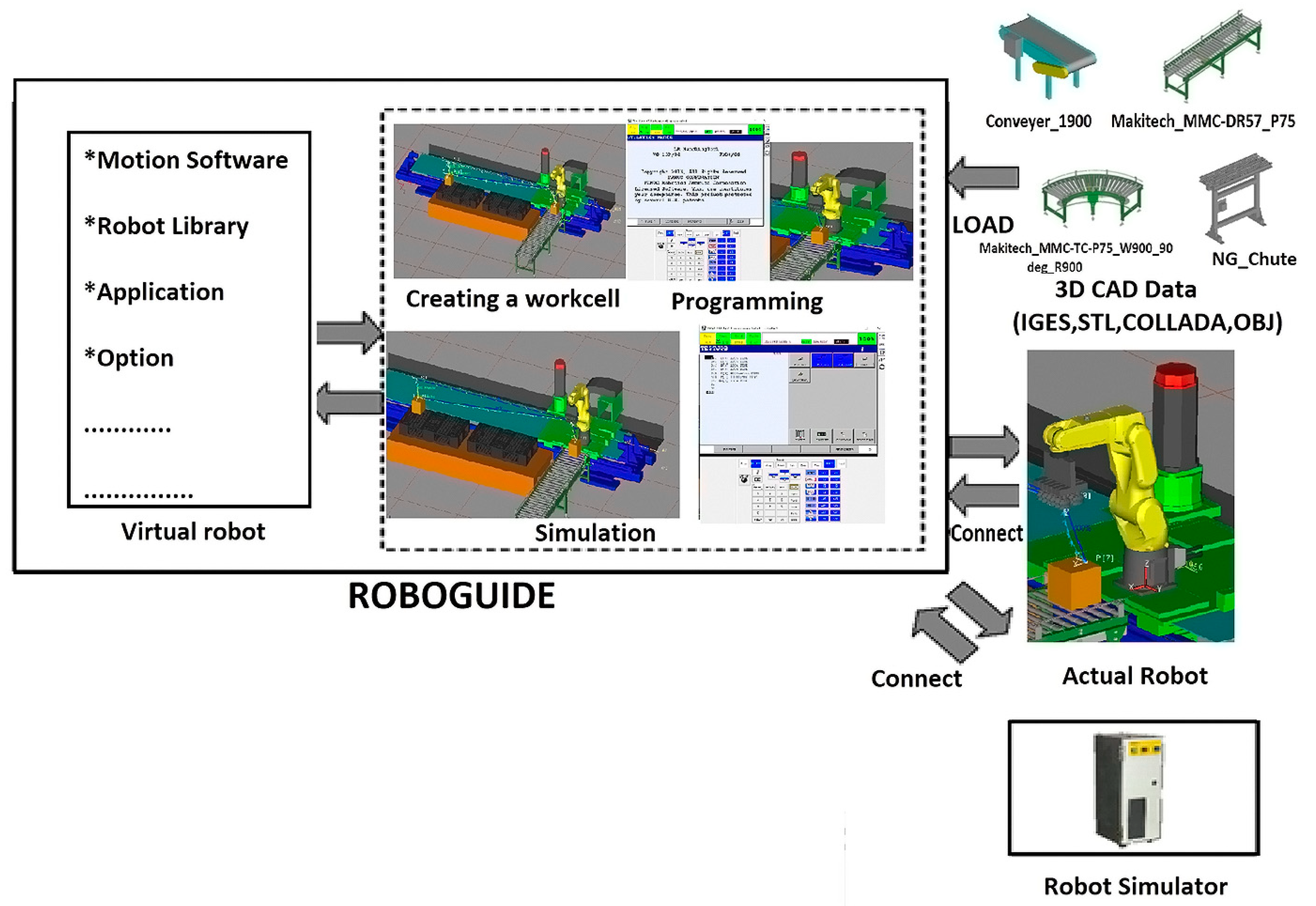
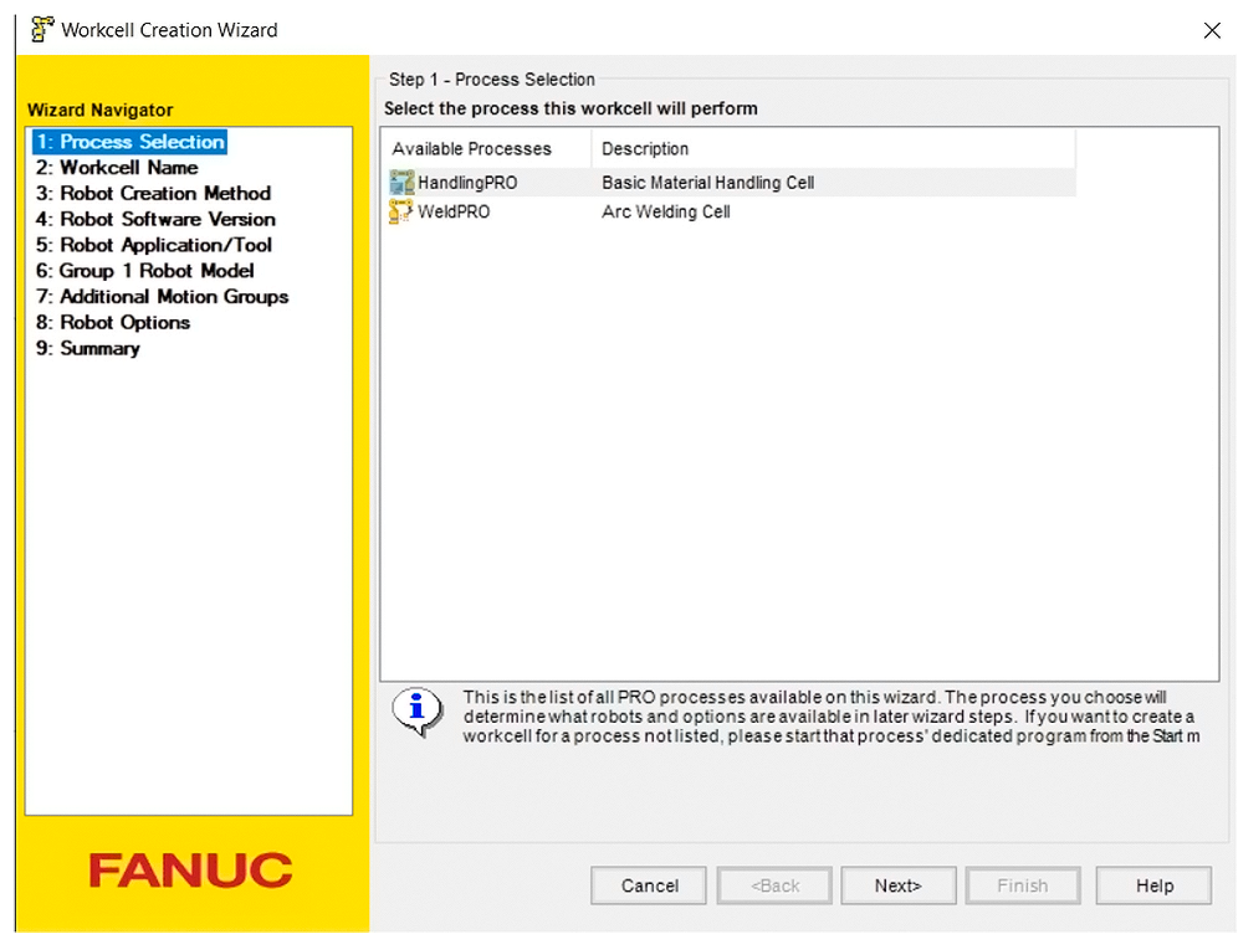

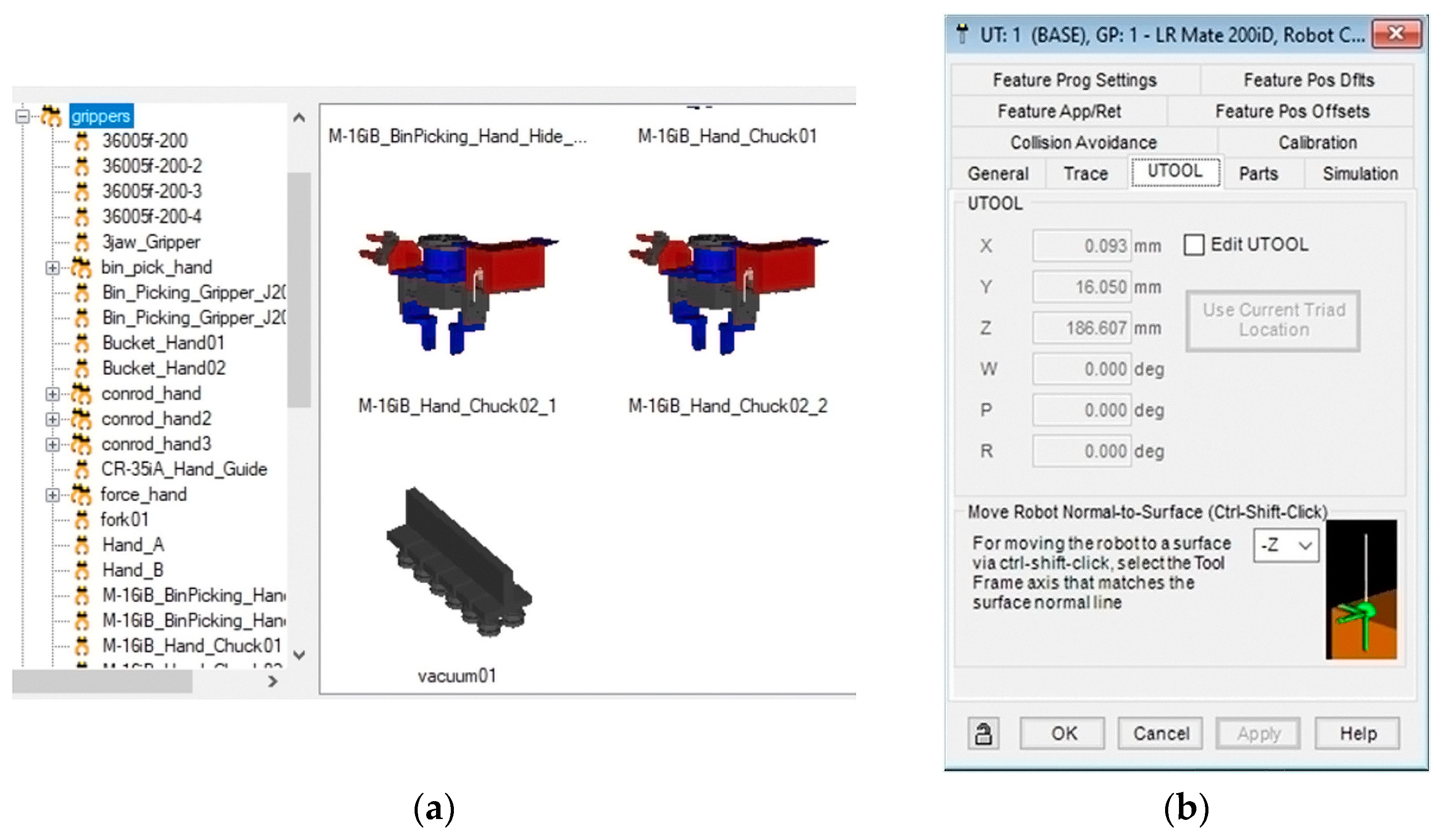

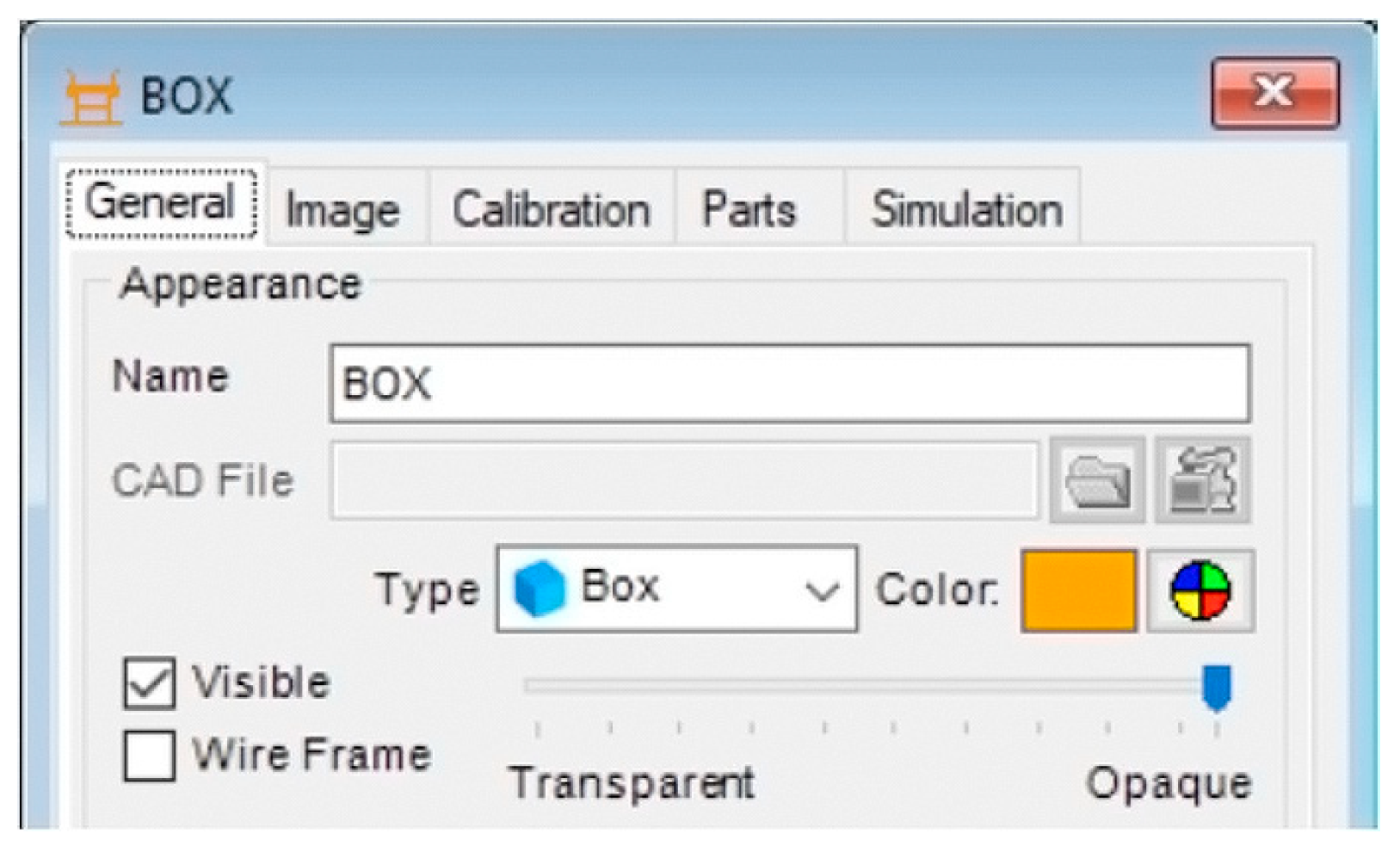
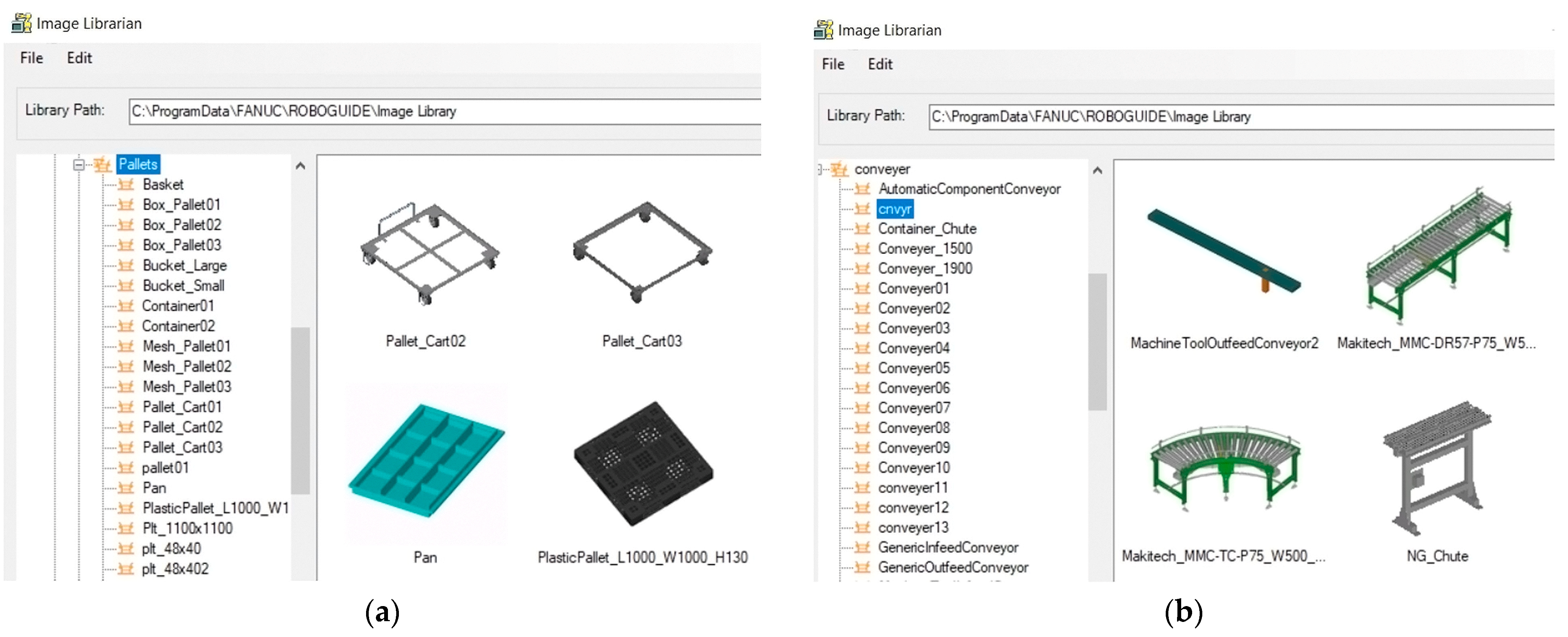
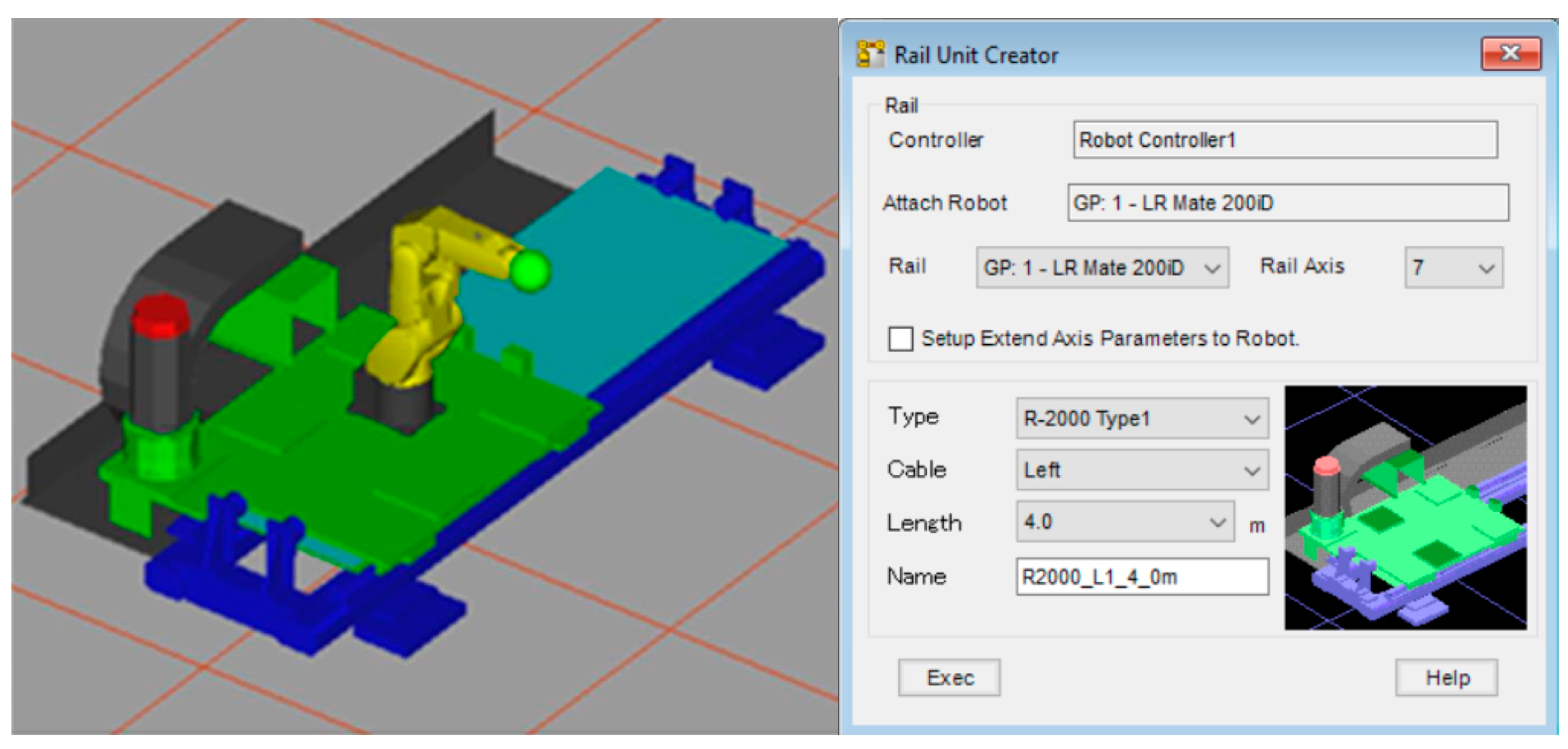
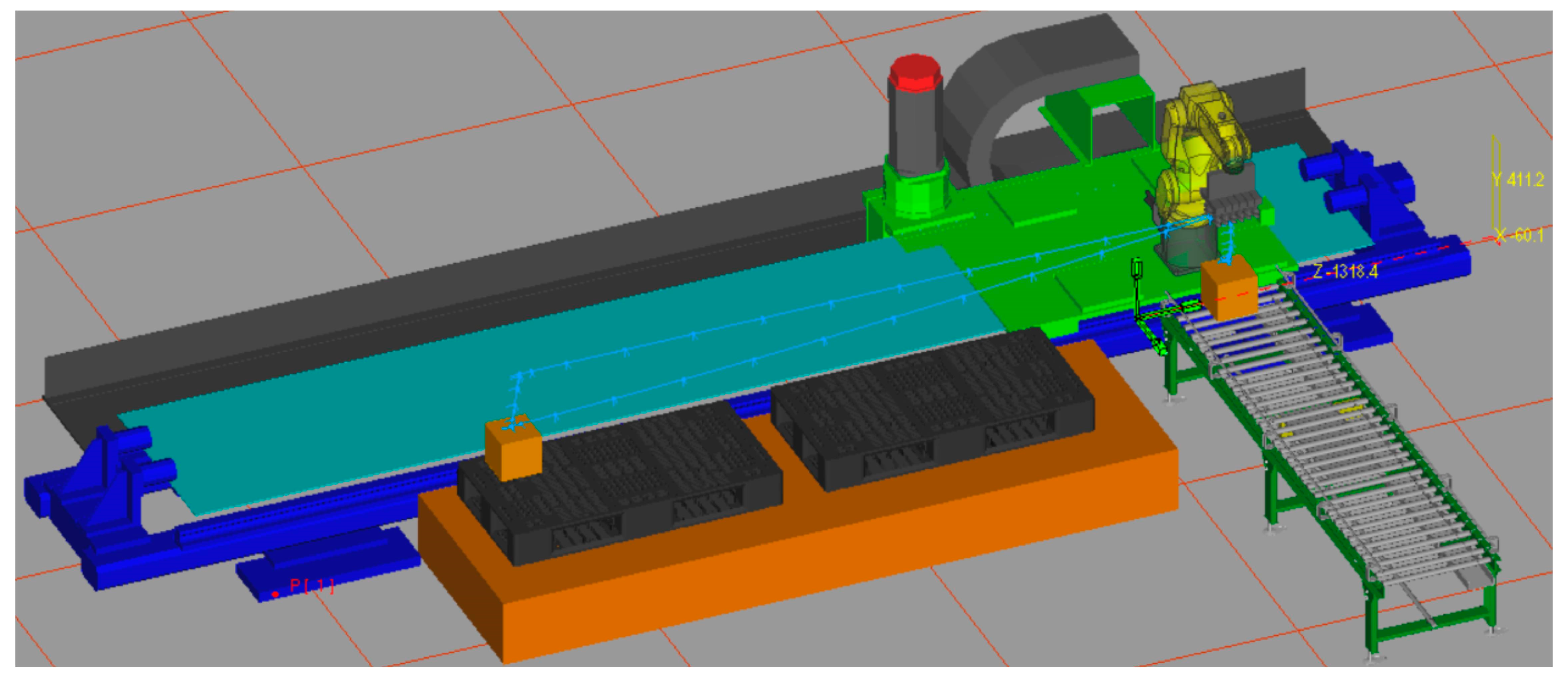


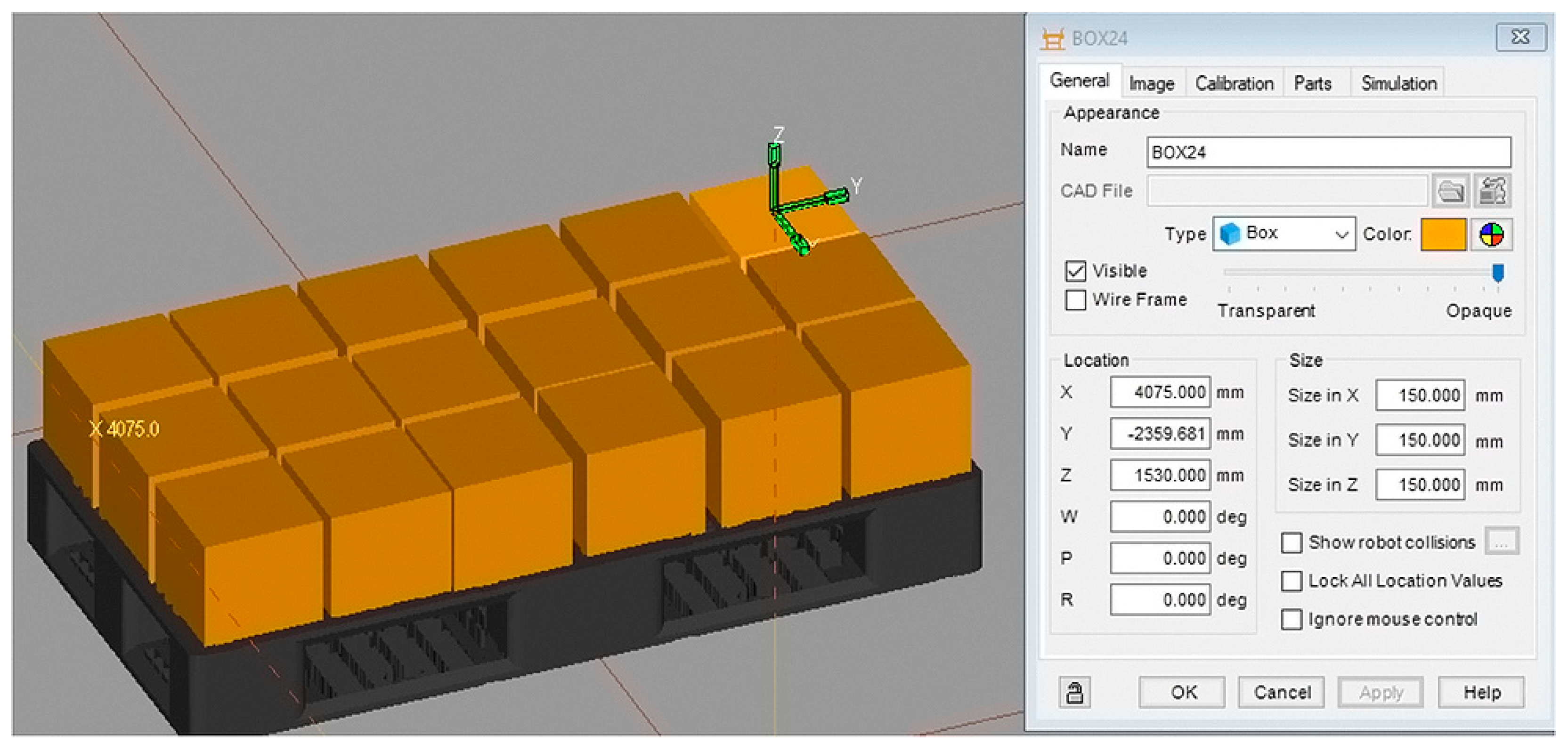
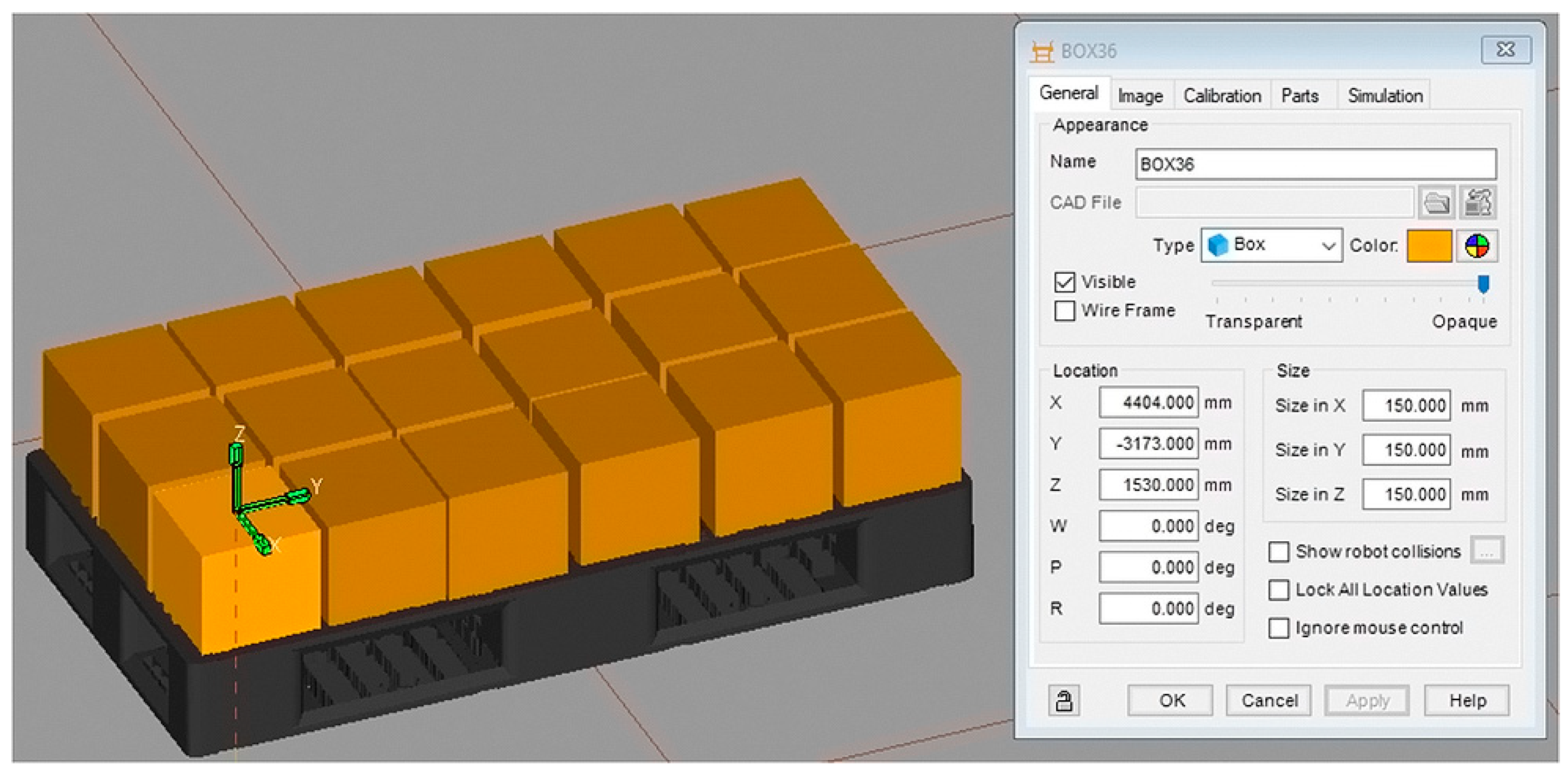

Disclaimer/Publisher’s Note: The statements, opinions and data contained in all publications are solely those of the individual author(s) and contributor(s) and not of MDPI and/or the editor(s). MDPI and/or the editor(s) disclaim responsibility for any injury to people or property resulting from any ideas, methods, instructions or products referred to in the content. |
© 2024 by the authors. Licensee MDPI, Basel, Switzerland. This article is an open access article distributed under the terms and conditions of the Creative Commons Attribution (CC BY) license (https://creativecommons.org/licenses/by/4.0/).
Share and Cite
Vladimirov, B.; Nikolov, S.; Tsolov, S. Programming Industrial Robots in the Fanuc ROBOGUIDE Environment. Eng. Proc. 2024, 70, 20. https://doi.org/10.3390/engproc2024070020
Vladimirov B, Nikolov S, Tsolov S. Programming Industrial Robots in the Fanuc ROBOGUIDE Environment. Engineering Proceedings. 2024; 70(1):20. https://doi.org/10.3390/engproc2024070020
Chicago/Turabian StyleVladimirov, Boryan, Stiliyan Nikolov, and Stanislav Tsolov. 2024. "Programming Industrial Robots in the Fanuc ROBOGUIDE Environment" Engineering Proceedings 70, no. 1: 20. https://doi.org/10.3390/engproc2024070020





